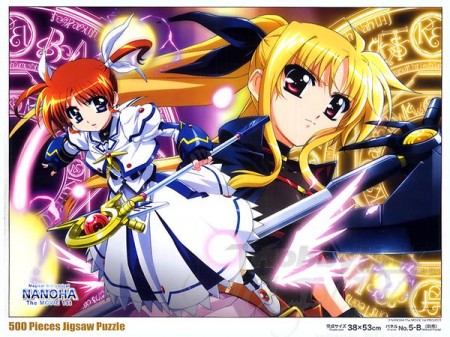Ask John: What Exactly Makes Lyrical Nanoha More Adult Oriented?

Question:
I am a fan of the Magical Lyrical Nanoha series and I know it’s target is for teens to young adults but I would like to know what elements of the Nanoha series make it for an older male demographic. Fanservice is in anime targeted at younger males so that isn’t it. There are mahou shoujo series that defy the common conventions of what a mahou shoujo series are suppossed to entail, and those are for younger girls. What is it about Nanoha that makes it more for older audiences?
Answer:
Nanoha Takamichi was seemingly always destined to star in a magical girl anime for young adult male viewers rather than preadolescent girls because Nanoha first premiered as a minor supporting character in studio Discovery’s adult PC game Triangle Heart 3, which starred Nanoha’s older siblings, Kyoya & Miyuki. The 2004 Magical Girl Lyrical Nanoha television series was intended from the outset to be a series for male otaku rather than female children, evidenced in its development and original broadcast. The show was animated by Seven Arcs, a studio which has never produced any children’s anime, and directed by Akiyuki Shinbo, who has worked on but never directed any children’s anime. Furthermore, the series was broadcast after midnight rather than during prime-time or early on a weekend morning when children’s anime usually air.
Two subtle elements distinguish Lyrical Nanoha from typical magical girl anime targeted at girls: the series’ tone, and more importantly, the presentation of its heroine. The Futari wa Precure television series predates Lyrical Nanoha by six months and introduced an unprecedented degree of fighting and violence into magical girl anime, but Lyrical Nanoha again evolved the action and violence in magical girl anime by giving it a more objective, scientific tone. Even in Pretty Cure, with its bruising hand-to-hand combat, the fighting and especially the magical beam attacks still had a personal, emotional undercurrent. The fighting was passionate. The beam attacks evoked and required the magical girls’ emotional engagement to perform. The magical battles in Lyrical Nanoha, however, feel more like magical gunfights. They’re not just painful; they seem deadly. And they’re far more objective and mechanical than the passionate fury of Pretty Cure. The action of Lyrical Nanoha feels like it borrows inspiration far more evidently from boy’s science-fiction and mecha anime than from traditional magical girl anime like Cutie Honey, Wedding Peach, and Sailor Moon.
The depiction of Nanoha Takamichi is also different in Lyrical Nanoha than the conventions of mahou shoujo anime. Traditional magical girl anime targeted at female children try to evoke viewer association. Traditional magical girl anime including Magical Emi, Creamy Mami, Minky Momo, Corrector Yui, Sailor Moon, Tokyo Mew Mew, Ojamajo Doremi, Card Captor Sakura, and countless others encourage young girls to identify with the anime heroines, imagine themselves in similar roles. These shows depict the heroines struggles with school, with friends, with neighborhood events in order to create lives that viewers can relate to. The Lyrical Nanoha anime, however, doesn’t try to create a similar empathy. Rather, Lyrical Nanoha tries to create sympathy. The Lyrical Nanoha anime depicts its protagonist with selective scenes and from a perspective that encourages viewers to feel for Nanoha Takamichi, love her, worry about her, but not necessarily want to be her or be like her. Typical magical girl anime for young girls, like Sailor Moon, Card Captor Sakura, and Ojamajo Doremi are directed from the protagonists’ perspective. Of course, the show’s perspective is omniscient, but it’s at a ground level, eye-to-eye with the heroines. Magical girl anime like Lyrical Nanoha and Senki Zesshou Symphogear are presented from a slightly more distant external, observatory perspective, the same perspective used for conventional otaku anime like Blood+, Full Metal Panic, Trigun, and Black Lagoon rather than the encouraging, engaged and participatory perspective of children’s and shounen anime like Naruto and One Piece.
Add a Comment
You must be logged in to post a comment.


I can assume the same could be said about the sequels in the series as well A’s, StrikerS, and Force?